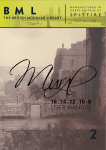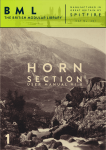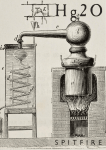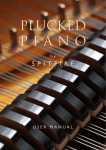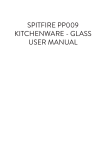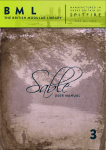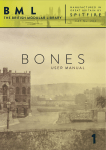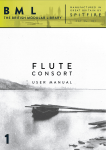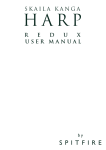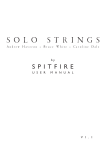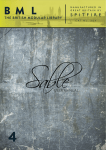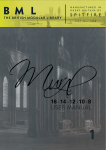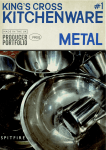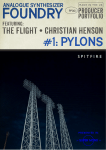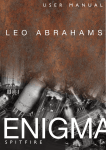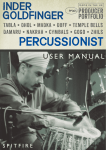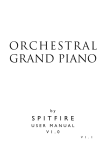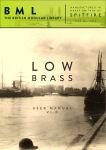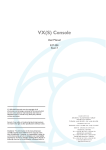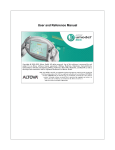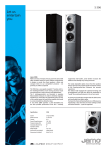Download SCRAPED PERCUSSION - Amazon Web Services
Transcript
SCRAPED PERCUSSION MANUAL U SUSER ER M ANUAL (PRINTER FRIENDLY) WELCOME Thanks for purchasing Scraped Percussion. We strongly urge you to read this manual as our ingenious GUI is packed with features not found yet in some of our other products. With particular attention to the Front Panel (page 7), which is designed lovingly to help you get the most out of these samples and to make them your own. About Spitfire Audio: Spitfire was formed in 2008 by a group of successful British composers as a means of producing the tools they needed for their busy work schedules. Sick of dry, humourless, ugly, unrealistic and enormously untamable sounding libraries, Spitfire set about redefining the way samples were created. Our aim is to reproduce the conditions of top movie recording sessions and approach sampling as if we were recording a film score one note at a time. We don’t imitate how film scores are recorded, we replicate them by using the same facilities, signal chain, techniques and musical & technical talent. We record performances and parts thereof, not scientifically created samples and importantly we record the room they play in. If you are wanting perfectly tuned, normalised or “dry” samples you have probably come to the wrong place. For here you may find the odd string squeak, a “fruity” note, and lots and lots of “room” but put the whole package together, write some beautiful music and suddenly this library and our approach will make perfect sense. In thanks to using the greatest talent we have available to us in the UK alongside the greatest facilities and technicians, Spitfire Audio supports the British music industry by paying the highest rates possible to it’s contributors alongside a royalty based on the success of sales. So in buying this software you are also supporting British musicians, studios and technicians and we thank you for that. About The “Definitive Range” Recorded by Jake Jackson at Lyndhurst Hall - Air Studios, on one of the finest scoring stages in the world, through an array of priceless vintage microphones via Neve “Montserrat” pre-amps, to a beautifully serviced Studer 2” tape machine and then into digital at 96k via the best Prism AD converters: this is an unparalleled signal chain. Spitfire’s definitive range endeavours to offer the world a one-stop shop for classic and esoteric instruments played by the greats. As all these instruments are recorded in situ, in the same place, they’re designed to lock together sonically whether it be some timpani from the percussion range, and your Sable libraries. Or indeed a more curious band made up of the HG20, a plucked piano and a harp, it is designed to sound like they’re together in the same room. We provide a series of fantastic mixing options that allow you to dry stuff up or make it more ambient should you so wish, whilst preserving the acoustic integrity and perspective of a slavishly recalled microphone set up and room configuration. This is now the 9th installment in our definitive range with plenty more to follow. Other “Definitive” Titles: Spitfire Percussion, Spitfire Harp, Solo Strings, Grand Cimbalom, Orchestral Piano, Plucked Piano, HG20, Harpsichord. PAGE 02 SCRAPED PERCUSSION. WHO KNEW A CYMBAL COULD MAKE SUCH A NOISE! We can’t believe it’s taken us this long. After our seminal “orchestral percussion” range and many “hitting” experiments with our Darwin sound banks (found in the Albion range). We’ve finally got around to bowing, rubbing, scraping and scratching! Found herein is a definitive selection of bowable, rubbed and scraped delights to add extraordinary, other worldy textures, flavours and colours to your music. From some glorious cymbals to the teeth shattering polystyrene cup. This is a definitive range of percussion played in ways the makers never had in mind! Performed by Paul Clarvis, one of the true session greats in London. This selection is made up from his experience being asked frequently by top-end A-list film composers and artists what they would like to add that extra “edge” and contemporary sonic architecture to their scores. Combined with the majesty of the hall at Air, that signal chain, that 2” tape, Jake Jackson’s mastery of the room and the mixes, and a beautifully programmed instrument that “just works”, we’re sure you’ll agree you’ve just laid your hands on something truly special. Before putting the keys in the ignition just a quick word on musicians. Without them we wouldn’t have this library. Its designed to help us all write better music for them to play. To hire smaller bands and have them play material that is appropriate to their size. We are not here to do away with musicians (we wouldn’t pay them a voluntary royalty from sales if we were!). So whenever you can, please go live, even if its one or two players. A single solo horn on the top line can make all the difference so even if the budget doesn’t permit, ask your producer or director to see what they can find down the back of the sofa. PAGE 03 CONTENTS SPECIFICATIONS5 LETS GET STARTED6 THE OVERVIEW PANEL 7 THE PANEL SWITCHER 8 THE ARTICULATIONS9 INSTRUMENT & ARTICULATIONS 10 MICROPHONE CONTROLS 11 EXPRESSION12 THE EXPERT PANEL13 THE MERCURY SYNTH 15 ADVANCED - MIXER17 ADVANCED - ARTICULATIONS 18 ADVANCED - SIDE BAR 19 ADVANCED - THE COG 20 A COUPLE OF TROUBLESHOOTS 21 A QUICK THANK YOU PAGE 04 22 SPECIFICATIONS KONTAKT The “Definitive” range is NOT a Kontakt Player library, so you WILL need a full version Kontakt to run it. PLEASE MAKE SURE YOU HAVE THE LATEST VERSION OF EITHER KONTAKT 4.2.4 OR 5 INSTALLED. Because this module doesn’t authorise through the NI Service Centre and is personally watermarked, you will be able to install on all the machines you own. Owning a full version of Kontakt will afford you the luxury of being able to edit and revise the patches to your particular preference. Remember we pride ourselves in making truly esoteric tools, so if there’s a sample you don’t like, you can change it for another with relative ease (check out the new Punch Cog on page 15 to see how you can easily do this). RECOMMENDED SPEC: The better your computer, the better the performance of any Spitfire module. But not to worry if you’re not spec’d up to the hilt. All programs are provided with a set of parameters that enable you to tone back the CPU demands of any given patch. But moving forward, we’re confident this module will keep your computer busy for many years to come! We recommend a combination of high processor speeds, a good chunk of memory and a devoted 7200rpm eSata, USBII, Thunderbolt, or Firewire audio drive. The more memory you have, the less demand placed on your drive, and having a totally devoted drive gives you the chance to load less into memory and reduce load times. The higher the speed of your CPU, the more capable your computer will be to deal with some of the amazing, but complicated scripts we’ve written. PCs: We recommend Windows 7 (latest Service Pack, 32/64 Bit), Intel Core Duo or AMD Athlon 64 X2, 2 GB RAM (4 GB recommended). MACs: We recommend Mac OS X 10.6, 10.7 or 10.8 (latest update), Intel Core 2 Duo, 2 GB RAM (4 GB recommended). DRIVES: Firewire, USBII, or eSata, 7200rpm. Ask your dealer for drives that are suitable for “AV use”. We always recommend as small a drive as possible, as the platter will be smaller and the seek time less. Depending on what mic positions and mixes you download the library will eventually take up 20-120 Gig on your hard drive. If using several large libraries, or a number of Spitfire modules from the same machine, we really recommend having your samples distributed over a number of drives. Lacie eSata or Quadras 7200rpm we highly recommend. Moreover, an exciting development lies in the recent arrival of some amazing solid state (SSD) drives. With seek times reduced to a fraction (0.1ms vs 6-9ms) of what standard drives can offer, we are certain you will be able to reduce your sampler’s “pre-load” (page 15.) buffer tenfold meaning you’ll be able to load enormous orchestral palettes into a single machine. HOST: The Kontakt 4 platform should work comfortably on most commonly found platforms and DAWs. As always make sure you’re as up-to-date as you can afford! If you’re planning on building or adding Spitfire to an already large orchestral palette, we recommend running your library independently of your DAW, either on your host computer (e.g. via Re-Wire) or on a slave device (e.g.. via Midi or MOL). This will assist your loading times, and will allow your DAW to do what it does best, sort out all your note ons and note offs! We heartily endorse Plogue Bidule (www.plogue.com) as a virtual rack/ routing system. For more advice and information about setting up please check our website. PAGE 05 LETS GET STARTED Because you’re reading this manual, we can presume you have successfully downloaded your Spitfire product. Included in your download email are some detailed installation instructions, please follow these carefully before going any further. We’ll see you back here, when you’re installed! Before opening Kontakt please make sure you have THE LATEST VERSION OF KONTAKT 4.2.4 OR 5 INSTALLED. 95% of all service enquiries relating to spurious or strange behaviour of our wares are solved by installing the most recent version. As this is NOT a Kontakt Player Library YOU WILL NOT SEE THE MODULE IN THE LIBRARY PANE. Simply navigate to the SCRAPED PERCUSSION via the “File” browser pane. If you have never used Kontakt before we wholeheartedly recommend your familiarise yourself with the basics of patch (or instrument) loading, multi management, outputting and MIDI routing detailed in the Kontakt user-manual provided with your copy of Kontakt or in the “documentation” folder of your Kontakt file. SCRAPED PERCUSSION FOLDER STRUCTURE ORIGINAL INSTRUMENTS As we recorded them, organised across the keyboard and arranged into articulations for ease of browsing and use: BICYCLE WHEEL CYMBAL GLASSES 1,2,3 ICEBELL MUSIC STAND SAW BLADE SONORI TAM TAM TUNED INSTRUMENTS We have taken some of the more tunefull instruments and extended their ranges in this unique small selection of playable instruments. STEPHENSON’S SCRAPES A unique bank of playable pads and drones derived from these recordings designed by a team of award winning film, TV, gaming composers and record producers. PAGE 06 THE NEW “OVERVIEW” PANEL MIC/ MIX POSITIONS EXPRESSION CONTROLS PANEL SWITCHER ARTICULATIONS PAGE 07 PANEL SWITCHER This toggles between the three different views available in scraped perc. 1. 2. 3. 1. OVERVIEW - The default GUI with a selection of easy to use parameters (Page 7). 2. EXPERT - The familiar Spitfire GUI with deeper tweaking parameters (Page 13). 3. THE OSTINATUM - Not available on this library... See other ranges. PAGE 08 ARTICULATIONS ARTICULATION STANZA On the right of the diagram above you will see a line of musical notes. These actually denote key articulations, display the current articulation playing and act as switches between them (alongside their associated keyswitches). We have created a series of presets with different articulations loaded (SEE PRESETS IN GENERAL CONTROLS PAGE 14). LOAD TOGGLES - The little RAM chips beneath the notes denote load status of the articulations. If you play an articulation that isn’t loaded, the front panel will alert you. Click on the chip to load/ unload. i Make sure Kontakt displays the instrument load status as pictured. If the left hand bar is illuminated and red it’s in a queue and hasn’t started loading yet, if the middle bar is lit and yellow the instrument is still loading up. If you try to play before it’s loaded it may not be nice! ARTICULATIONS - Click on these notes to select the different articulations, whatever articulation is live is displayed in the yellow sidebar on the left. You can also select different articulations by hitting key switches, you can do this whilst you’re playing so if you want to say switch from a “long” articulation to a short, hit the key whilst you’re playing your last long and the next note will be a short. For more advanced selection options turn to page 16. A brief guide to these articulations is displayed overleaf... PAGE 09 INSTRUMENT & ARTICULATION LIST Bicycle Wheel - Bowed Long - Bowed Short - Bowed Swells - Serrated Rod - Strummed Spokes Cymbal - 5pence - Bowed Longs - Bowed Shorts - Long crescendos - Serrated Longs - Serrated Shorts - Stick Longs - Stick Shorts - Superball Longs - Superball Shorts Glasses 1,2,3 - Bowed Longs - Bowed Shorts - Scraped Longs - Scraped Shorts Icebell - Longs - Shorts Music Stand - Longs - Shorts Saw Blade - Crescendos - Bowed Longs - Bowed Shorts - Scraped Longs - Scraped Shorts - Superball Sonori - Bowed Longs - Bowed Shorts - Scraped Longs - Scraped Shorts TamTam - Chord Long - Chord Short - Dreadlock Long - Dreadlock Short - Drumstick Long - Drumstick Short - Bowed Long - Bowed Short - Serrated Long - Serrated Short - Shimmer - Superball Long - Superball Short - Triangle Long - Triangle Short Polystyrene Cup - Longs - Shorts PAGE 10 MICROPHONE/ MIX SETTINGS Welcome to the wonderful world of Air Studios and the mixes of our chief engineer Jake Jackson. Use the chips beneath the faders to load unload different microphones and the faders above to tweak the balance of them. Turning a fader all the way down will also unload the mics, conversely turning the fader back up will reload. Left click on the faders to assign CC controllers so you can mix these live for fantastic shifts in the spacial nature of the samples. MICROPHONES / MIXES Right/ Ctrl click on the mic letters to change Kontakt channel/output assignment. STANDARD ARRAY: C - Close mics, a selection of valve mics placed for optimum focus close to the instruments. This mic control is great to add in for added definition and at times a bit of “rounding of sound”, in isolation it can be a way of achieving a more intimate or pop-music style sound. T - Tree. This refers to the “Decca” tree of three mics placed above the conductors podium. These are placed to give the ultimate sound of the band, the hall and they are the default mic position that loads in with each patch. A - Ambient. A set of condenser mics placed high up in the gallery away from the band. This mic position gives a massive amount of stereo spread and room sound over the band. Great mixed in with the other mics but also ideal fed to your Ls & Rs speaker sends for true surround information. O - Outriggers, a set of vintage mics placed wide apart to the left and right of the tree. These give a similar balance of room and band but with a broader stereo spread. The effect of this mic is somewhere between the tree and ambient mics. EXTENDED ARRAY: CR - Close ribbons. Placed next to the standard close mics but using a rarefied selection of vintage ribbon mics to add a warm and rounded tone. ST - Stereo Mic. These are totally different mics in a totally different position to the tree (closer to ground level) and have a more direct and immediate sound than the tree. Mi - Mid Range. As above but with greater depth and perspective. These mics are placed midway between the Tree and the Stereo array. G - Gallery mics, three mics at the very furthest point from the band way up in the gallery. A true representation of Air-Studios’ amazing ambience. PAGE 11 EXPRESSION CONTROLS As this library is largely a grab bag of colours and one shots there is one solitary controller option displayed on the GUI. EXPRESSION - CC#11 Displays the overall instrument volume (0-100%). Remember you can also trim your instrument volume with CC#7. PAGE 12 THE “EXPERT” PANEL GENERAL CONTROLS EXPRESSION CONTROLS DEFAULT CCs ARTICULATIONS PAGE 13 CC1 CC11 CC16 CC21 CC22 CC23 CC24 CC25 CC32 - Dynamics - Expression (0-100% fade) - Speed - Vibrato - Mic 1 slider - Mic 1 slider - Mic 1 slider - Mic 1 slider - Articulation control GENERAL CONTROLS OPTIONS PRESETS - This allows you to load predetermined sets of articulations affectionately called articulation sets (see page 5) quickly and easily to optimise your system quickly for essential articulations or to start building templates using empty “shells”. PURGE UNUSED - This control keeps unloading any samples you are not using to keep your memory usage as low as possible. TRANSPOSE - Toggle this on and tweak the number to the right to transpose your instrument. Note this is not the same as tuning, the instrument will actually offset the samples to the selected pitch. CC MAPPED VEL(OCITY) - Click this to control note velocity with the Dynamics slider. If a user has customised the dynamics slider, that same customised CC will control velocity now. EXPRESSION CONTROLS Smaller representation of faders discussed in the new “Overview” Panel (page 12). PAGE 14 SCRAPED PERCUSSION MERCURY SYNTH 2. 3. 1. 7. 4. 10. 5. 6. 7. PAGE 15 8. 9. THE Hg2O MERCURY SYNTH Although these sound excellent out of the box we’ve also given you an easy to use and ingenious front panel. 1. Lo & Hi Pass Filters LPF = Low, HPF = Hi. For some, a counter intuitive industry standard in titling. Adjust the graph on the LPF to chop off the top end, HPF to chop off the bottom. So if you want to reduce your fizzing synth sound to a muted sub tone drag the LPF graph from right to left. 2. Wobble Amount Three modulator windows that give you wobble, or sometimes, WAB WAB WAB! Adjust the AMT to effect the amount of WAB WAB. 3. Wobble Frequency Adjust the graph to change the frequency or speed of your wobbles. For tempo sync’d modulators this will tune coarsely to provide you with 8th triplet 16th, etc etc. 4. A.D.S.R. Attack, Decay, Sustain Release envelope. These knobs will adjust the shape of the sound from a volume point of view. Adjust attack to make the sound come thudding in or gradually fade in. Adjust release to make the sound go from a sharp end or off to a gradual decay. For an 808 style bass pull up one of the subbier sounds and pull the attack all the way to the right. The release to about mid way (to taste) and play some short notes. 5. FX Parameter Display We’ve pre-loaded a selection of FX. Activate by clicking the FX icons along this bar. 6. Portamento Glide On/ Off Toggle Click this to make the sound monophonic (so you only can play one note at a time) and to activate the portamento glide function. 7. Portamento Glide Amount Now that your Glide toggle is on hold one key down and whilst holding press another. Because you’re in monophonic mode the sound will transition from the first pitch you depressed to the second, this fader controls the time this transition takes. 8. Yoke X&Y FX Selector The yoke (10.) is a dual FX controller that adjusts your FX parameters in real time for fantastic sequencing options. Y = vertical controller, X = horizontal. Scroll down to select which FX you wish to control. 9. Yoke X&Y FX Parameter Selector Determines which parameter from your selected FX you wish to map to the X or Y yoke controller. You can also alter the FX parameters further and map them direct to the Yoke controller (right/ ctrl click) by accessing the additional FX parameter Bar; Command/ Right Click on the FX Icon you’d like to acces additional parameters for. PAGE 16 ADVANCED STUFF - MIXER MENU 1. 2. 3. 4. CLICK ON THESE ICONS FOR DEEPER MIX CONTROL: 1. VELOCITY RESPONSE Pick from 4 different velocity curves to suit your controller. 2. CLOSE MIC PAN COLLAPSER The close mics are a stereo mix and this collapser allows you to refine how the stereo image is handled. All our musicians are recorded in-situ, i.e. where they would be seated on a standard scoring session, giving you a fantastic spectral spread when putting all the elements together, which helps define the detail. This panning tool helps you to manage and tweak this to your own tastes/ needs. STEREO WIDTH - Allows you to control how far the stereo image reaches. All the way to the right would be like having your two pan pots panned hard. All the way to the left would be like having both pots centre. STEREO PAN - Then allows you to control where in the pan field the centre of this image is placed. 3. MICROPHONE MIX TO ARTICULATION LINKER The small notation symbol locks the microphone mix or tweak you’ve made to the articulation selected. This means if you want to boost any perceived inconsistencies in volume between say pizzicato and col legno you can. Or indeed if you want to roll off some of the hall ambience for a short versus the long articulations this is how to fine tune. 4. MIXER PRESETS A new way to transfer mixer settings between patches, or save and load presets to disk. AUTOMATING MIXER FADERS - Each mixer fader has a dedicated #CC. To change this to suit your MIDI controller or surface, simply right click (on PC) or command click (on Mac) on the fader itself to “learn” the new controller. ROUTING MIC MIXES - To route each mic ixer channel to unique Kontakt channels simply click on the Mic acronym. Great for putting your ambient mics in the surround for example. Also good for tracklaying individual mics for your engineer to control in your final mix sessions. For more information regarding Kontakt audio channels & routing please consult your Kontakt User Manual. PAGE 17 ADVANCED STUFF - ARTICULATION SELECTION LAYERING: To layer sounds within the articulation set, simply ‘SHIFT’ click on your next articulation. Rather than introducing a multitude of more confusing ‘layered articulation’ options, the front panel shows (and edits) only the most recently layered articulation. TRIGGERING: For triggering options CTRL or COMMAND click on the articulation icon: “By CC Range” - This will allow you to use a single controller channel to switch between artics. This allows you to fine tune on your MIDI event list, or to use a midi controller fader or indeed button with a single range assigned to select your desired artic’. Our default setting is guided by our UACC protocol (see page 23). “By KS” - The default setting. BML is scripted so it won’t switch mid note but wait ‘til the next not-on event before switching. This means you’re able to play the key switch say whilst playing a long note and have it switch to a staccato on your next note. “By Velocity Range” - This is great for designing intelligent staccato patches that say become staccatissimo when you hit the keyboard really hard. A second menu will open up giving you options for this function. “By MIDI Channel” - Ingeniously turns your single instance of scraped percussion into a multi timbral instrument. MIDI channel lets the instrument change articulation based on the incoming MIDI channel. To use, pop the instrument Midi Ch. to ‘Omni’ mode in Kontakt. The single instance can now be configured to play based on the incoming MIDI channel. For example. Set staccatos to channel 1, longs to channel 2 , legato to channel 3. “By Speed Of Playing” - A revolutionary new function that allows you to switch articulations based on the playing speed of your performance. When selected, it provides options to specify a triggering time-range in milliseconds. (See right hand menu above). For example, you could specify that ‘fast legato’ should be activated if the time between playing each interval is between 0 and 250ms (pictured above). Fully configurable to suit the user’s playing style and needs and can be deactivated by unchecking ‘Enabled’ (or if not in the artic switching screen, simply holding ALT/MENU and clicking the articulation icon on the stanza). PAGE 18 ADVANCED STUFF - SIDE BAR OPTIONS 1. 2. 3. 4. 1. “THE COG” - An awesome tool for fine tuning and tweaking your patches. See page 19. 2. “KEYBOARD SHIMMIER” - This shifts your bank of keyswitches left or right to suit your needs preferences or performance. 3. “KEYSWITCH TO CC SELECTOR” - Use this to assign a CC controller to act as articulation/ keyswitcher. Click on “CC” and you’ll be prompted to move the controller you wish to use in order for the instrument to “learn” how you’d like to select articulations. 4. “ARTICULATION LOCKER” - We all like to select articulations and use our templates in different ways. Many composers like to have a single articulation loaded to each instance of an instrument for example. So its worth locking off the articulation switching once you’ve selected one so you don’t have sounds disappearing from slaves way off in your machine rooms! Unlocked Artic’ - Is the standard setting, select articulations via the front panel or associated keyswitch. Locked Artic’ - This locks your articulation so it doesn’t change either via front panel or keyswitch. Locked Keyswitch - This locks your articulation via keyswitch but you’re free to switch via the front panel. Locked to UACC - This is a new standard being developed by Spitfire and detailed on page 21. The default controller channel is #32 but this can be changed by right/ CTRL clicking on the padlock. PAGE 19 ADVANCED STUFF - THE PUNCH COG As we record our samples like you would a film score, we actively encourage our musicians to make every note sound different. To play with the flair that would be expected from them on a score shoot. We like tuning imperfections, little squeeks, the odd breath of a human! We like our pizzicatos loose and for the odd “rub” between players when playing transitions. However much we apply our exacting taste principals onto our range we’re never going to meet with everyone’s preferred quality bar, or needs and expectations of a project. So we present to you Blake Robinson’s coup de grace.... A way of punching notes in and out like we used to in the old days. A way of customising your library to fit your taste and needs. If there is a round robin you don’t like or a long note where the tuning is a bit fruity. Switch to the articulation you were using. Play until you find the Round Robin you don’t like and then stop. Observe the pictured cog bottom left of the front panel/ UI, and click on it to get this dialogue: HOW SHOULD WE TWEAK - Then your last note played will be displayed, if this is correct get tweaking. SKIP THIS RR - Will simply make it always jump along to the next round robin in the cycle. ADJUST TUNE/ VOL - Will adjust the tuning and or volume of the last played note. ADJUST RELEASE - This will alter the level of the release trigger (which will effect the percieved decay of that note). SAMPLE START - If it feels loose adjust to the right, tight adjust to the left (NB this is only available in full “cog” patches). REMOVE ALL NOTE TWEAKS - This removes all custom changes you have made with the Cog. PAGE 20 A COUPLE OF TROUBLESHOTS This is a manual to accompany v1.0 of a totally new line for Spitfire. With a totally new set of samples, scripts, and UI. We have used our experience as busy film composers to deliver something that we’d like. It is our hope that you keep in touch with us to let us know how you’re getting on, how you’re using BML, how you’re finding it, and, if we were to consider looking at areas in the future, what you’d like us to look at. From this we’ll form a consensus and wholeheartedly pledge that we will act upon it wherever possible or practical. We’ve already recorded new material which will be distributed for free in service updates. We do this because, even after years of experience, it’s not always easy to predict how things turn out. So we leave space in our budgets to go back and record stuff that may not have worked as well as we like, may need expanding upon, or to widen the scope of something that’s surprised us and we want to make more of. Keep an eye on your in-box and our site for new additions to the BML range and others and of course our site. A couple of commonly asked questions... • This library really isn’t behaving how I’d expect. - OK, so we’re now officially blue in the face. But before you go ANY further please check you are using the ABSOLUTE latest version of Kontakt. Visit your trusty service centre and we hope this page remains relatively under-thumbed. • My instrument or patch seems to be playing just bits of sound, some keys are missing, and there’s lots of clicks and crackles. - Make sure that your patch is fully loaded (detailed on the front panel, page 8). Some of these are biggies so can take a while. But if problems persist make sure Kontakt memory manager is activated: then: You’ll have to restart this instance of Kontakt to feel it’s benefits. Another reason your system may be struggling is that you’re using too many mics live for the spec of your machine. Try cutting the mics as detailed on the front panel to see if this cures your problem. If it does, don’t worry you can still use these mics, just play in your parts with one active (we recommend the T(ree)) and then activate multiple mics and render down (eg. freeze function in Logic Studio). Some DAWS (ahem, Logic) only use one core of your computer when recording but will use more when playing back so again try recording with just one mic then dial in others once you’re happy. If you’re still suffering may we suggest you try and manage your pre-load buffer. Kontakt pre-loads some samples into memory so that when you hit a note Kontakt plays it out from RAM whilst addressing the rest of your samples from your hard drive(s). The slower your drives, the more you may want to rely on RAM, the faster the drives, or smaller RAM available, the more you may want to rely or your drives. If you’re using the latest generation of SSDs you’ll find you can radically reduce your pre-load buffer. Referring to the plate above tick the “Instruments Default Pre-Load Buffer Size” and drag the fader to a setting you’re happy with. PAGE 21 A QUICK THANKS Christian & Paul would like to thank Paul Clarvis, Dominic Kelly, Alison Burton and the whole of the Air Studios team. To Jake Jackson for making everything sound so marvellous, and the remarkable talents, immense intellect and invention of James Bellamy, Stanley Gabriel, Andrew Blaney, Blake Robinson, Stu Kennedy, Joe, Toby, Seb, and Jess. Most of all we would like to thank the amazing support and loyalty of our user-base, our Facebook friends and everyone at VI Control. We are in the same boat as all of you. We’re not content and software developers by trade, so appreciate your honesty in paying your way to be a part of our family and not distributing this illegally. But more importantly, if you have any ideas or criticism please let us know directly via our website in a constructive manner. You never know, you just may have thought of something that we hadn’t considered. We want to make our entire range the best there is, and we rely on you to help us achieve that..... With thanks. Christian & Paul. COPYRIGHT SPITFIRE AUDIO LLP 201 www.spitfireaudio.com PAGE 22






















